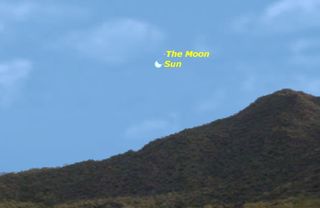Partial Solar Eclipse to Darken Southern Africa's Skies Sunday

The penguins are in luck, as are some skywatchers in the Southern Hemisphere: A solar eclipse will be visible from Antarctica, southern Africa and the Indian Ocean on Sunday (Sept. 13).
The best view of this partial solar eclipse — the third of four solar or lunar eclipses this year — from an urban area will be from Cape Town, South Africa, where the moon will cover a maximum of 30 percent of the sun. The eclipse will begin in Cape Town just as the sun and moon are rising at 6:49 a.m. local time. Early risers will see a tiny bite out of the sun. At 7:43 a.m., the eclipse will reach its maximum, and by 8:50 a.m., it will be over.
This eclipse will be visible throughout South Africa, and also in southern parts of Madagascar, Mozambique, Zambia, and Zimbabwe. It will also be visible over a wide area of the Indian Ocean and Antarctica (which is good news if you happen to be a penguin). [Solar Eclipses: An Observer's Guide (Infographic)]

The best way to observe a partial solar eclipse is with a filter specifically designed for viewing the sun. Stores specializing in telescopes sell these filters. Safe "eclipse shades" are often widely available prior to an eclipse. A No. 14 welder's glass also works well, and is available from specialized welding shops. The ordinary, No. 12 welder's glass sold in hardware stores to protect welders' eyes from extremely bright light does not provide adequate protection from the sun.
If you don't have a proper solar filter, you can view the partially eclipsed sun with a pinhole camera by punching a hole about a millimeter in diameter in a piece of cardboard. Natural "pinholes" created by leaves on trees or reflections from a building's windows will also work.
Under NO circumstances look directly at the sun, even with sunglasses, as you can quickly cause permanent damage to your eyes. If a small magnifying glass can light a fire in seconds, think what will happen to the retina of your eye by staring at the sun.
Editor's note: As always, we welcome your pictures of the partially eclipsed sun; a solar filter on your camera will be essential. (The sensor in your camera is just as easily damaged by the direct sun as are your eyes.) Try to get a landmark or tree in the foreground to give a sense of scale. You can send images and comments for possible use in a future story or gallery to managing editor Tariq Malik at: spacephotos@space.com.
Get the Space.com Newsletter
Breaking space news, the latest updates on rocket launches, skywatching events and more!
This article was provided to Space.com by Simulation Curriculum, the leader in space science curriculum solutions and the makers of Starry Night and SkySafari. Follow Starry Night on Twitter @StarryNightEdu. Follow us @Spacedotcom, Facebook and Google+. Original article on Space.com.
Join our Space Forums to keep talking space on the latest missions, night sky and more! And if you have a news tip, correction or comment, let us know at: community@space.com.

Geoff Gaherty was Space.com's Night Sky columnist and in partnership with Starry Night software and a dedicated amateur astronomer who sought to share the wonders of the night sky with the world. Based in Canada, Geoff studied mathematics and physics at McGill University and earned a Ph.D. in anthropology from the University of Toronto, all while pursuing a passion for the night sky and serving as an astronomy communicator. He credited a partial solar eclipse observed in 1946 (at age 5) and his 1957 sighting of the Comet Arend-Roland as a teenager for sparking his interest in amateur astronomy. In 2008, Geoff won the Chant Medal from the Royal Astronomical Society of Canada, an award given to a Canadian amateur astronomer in recognition of their lifetime achievements. Sadly, Geoff passed away July 7, 2016 due to complications from a kidney transplant, but his legacy continues at Starry Night.

